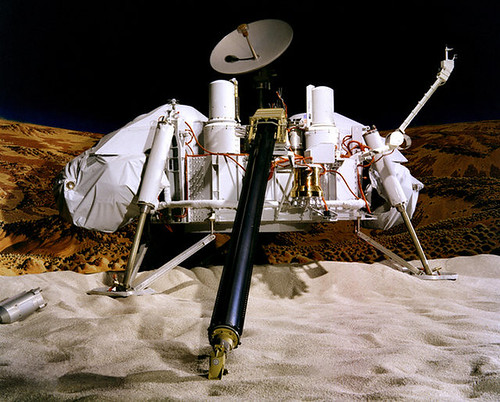The Viking 2 spacecraft lands at Utopia Planitia on Mars.
Fresh off the success with Viking 1, NASA landed on Mars again on Sept. 3, 1976 with Viking 2.
Sister ship to Viking 1, Viking 2 set down on the broad, flat plains of Utopia Planitia, where it snapped photos of morning frost and – like its predecessor – found a sterile soil that held no clear evidence of microbial life. The lander shut down in 1980.
CREDIT: NASA
NASA’s Viking 2 was a joint orbiter-lander mission that saw the second U.S. landing on Mars on Sept. 3, 1976. Viking 2’s lander touched the Red Planet just weeks after its sibling, Viking 1.
The lander spent more than three Earth years on the surface taking pictures of the surrounding area, analyzing the regolith in front of it, and even conducting life experiments. Meanwhile, the orbiter snapped shots of craters, channels and other Mars features from above.
The Viking program provided the first up-close look at Mars, for several years running. It gave researchers a sense of what it is like to live and work on the Red Planet.
When Vikings 1 and 2 sent back the results of their life experiments, NASA said at the time that there was no definitive evidence of life. That’s been called into question in the decades since.The entire Viking program hardware – two orbiters and two landers – cost $1 billion in 1970s dollars, or anywhere from $4 billion to $6 billion today.
While that is a large sum, this is actually half the cost of a proposed NASA Mars landing program called Voyager.
Voyager was supposed to fly to Mars using a Saturn V rocket, the same rocket that took astronauts to the moon between 1968 and 1972. The Voyager lander would last two Earth years on the surface.
However, NASA had less money to go around after the Apollo program finished and congressional priorities shifted. The agency was facing a money crunch, and elected to shelve the program in favor of something simpler.
That’s not to say that Viking was unambitious. If all went as planned, NASA would do two “soft” landings on Mars – something the agency had never attempted before. The landers would function for at least 90 Earth days or 120 Martian “sols” on the surface. Meanwhile, the orbiters would carry the landers to Mars and send scientific information back to Earth.

